译林版(2019) 选择性必修第一册 Unit 1 Food Matters Extended reading & Project 课件(40张PPT)
文档属性
| 名称 | 译林版(2019) 选择性必修第一册 Unit 1 Food Matters Extended reading & Project 课件(40张PPT) | 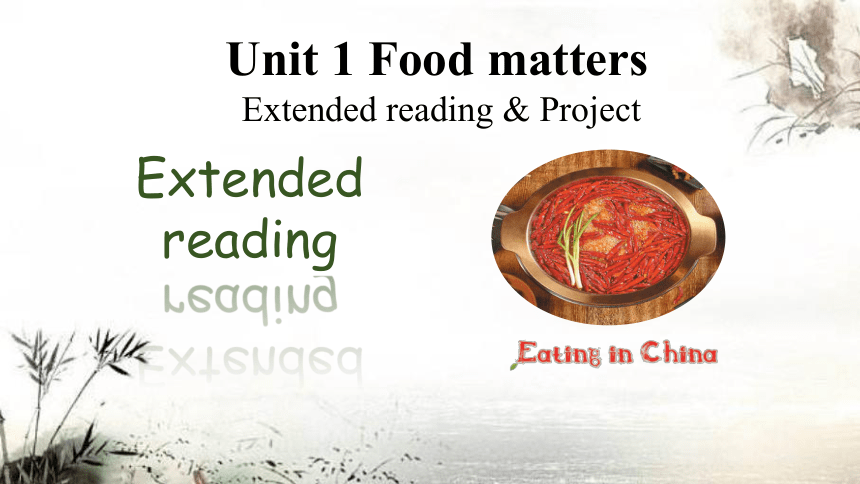 | |
| 格式 | pptx | ||
| 文件大小 | 35.0MB | ||
| 资源类型 | 教案 | ||
| 版本资源 | 牛津译林版(2019) | ||
| 科目 | 英语 | ||
| 更新时间 | 2022-10-07 14:04:25 | ||
图片预览

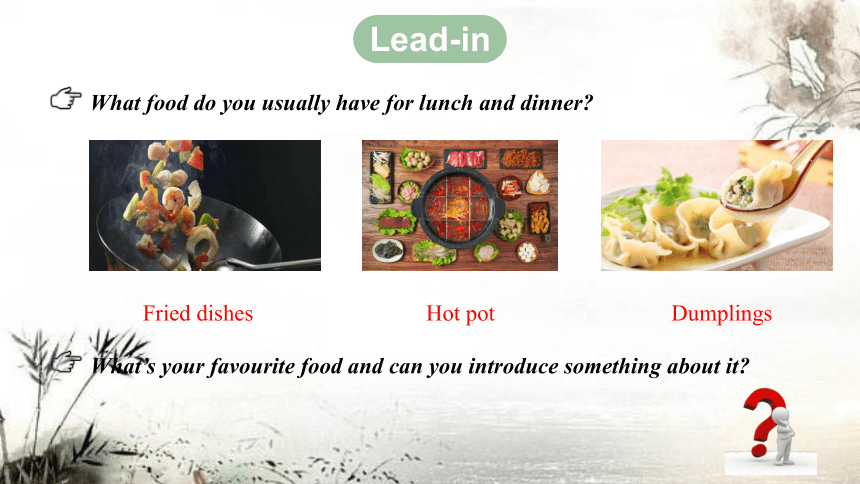
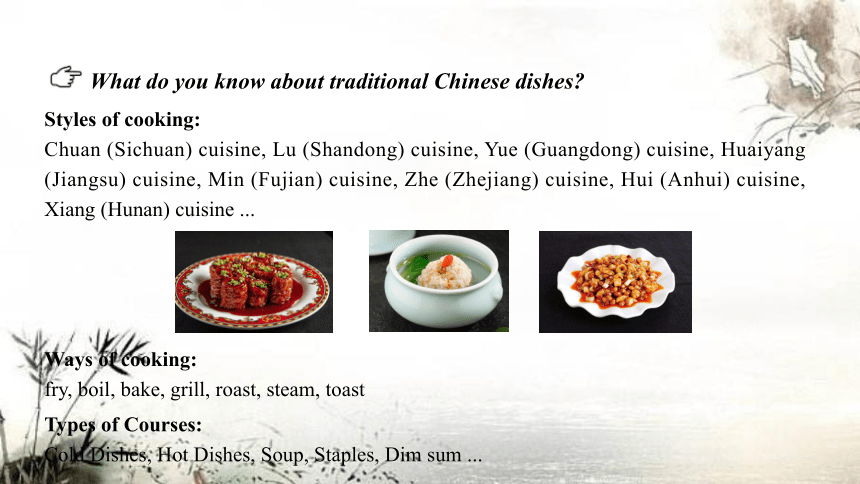
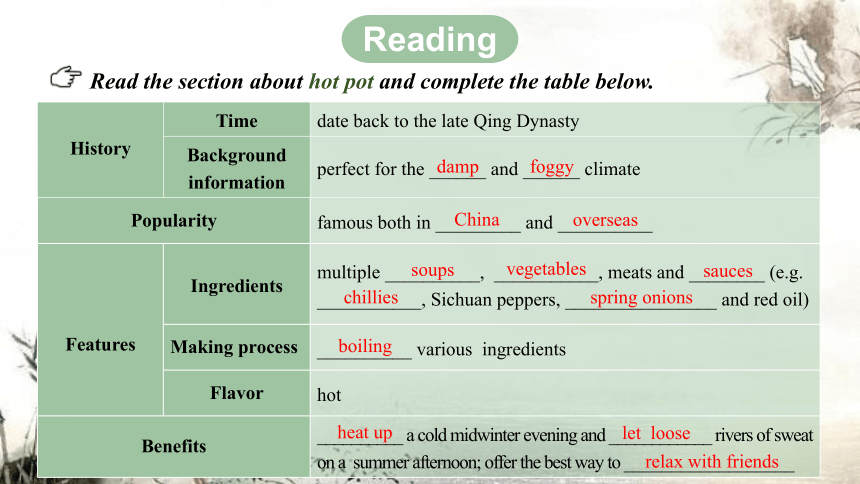
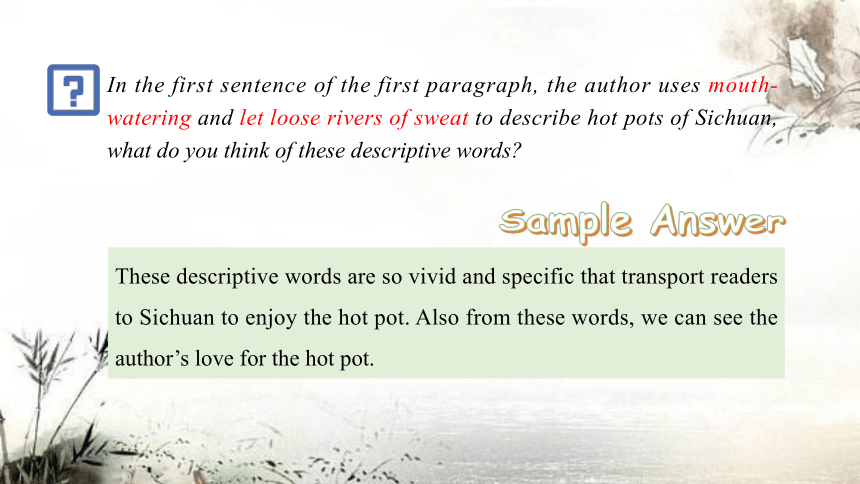
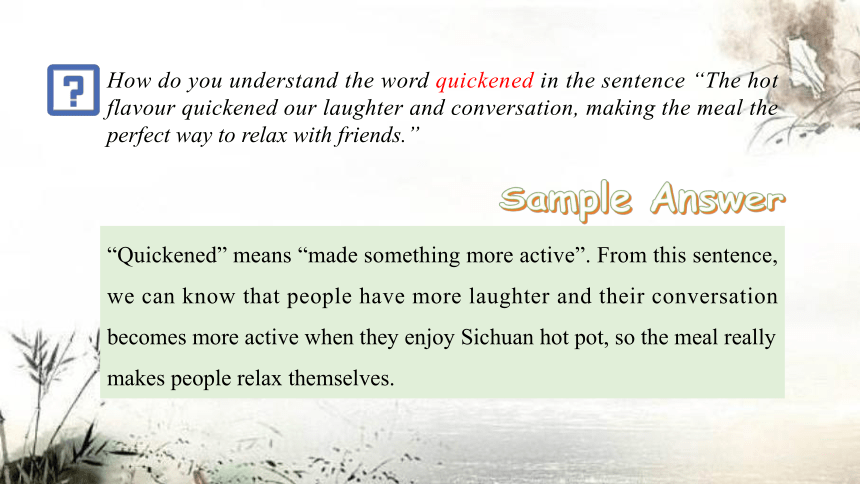
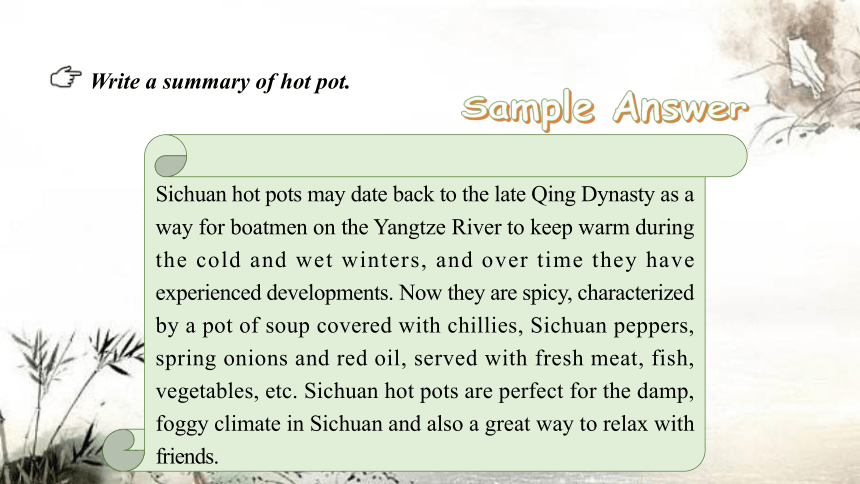
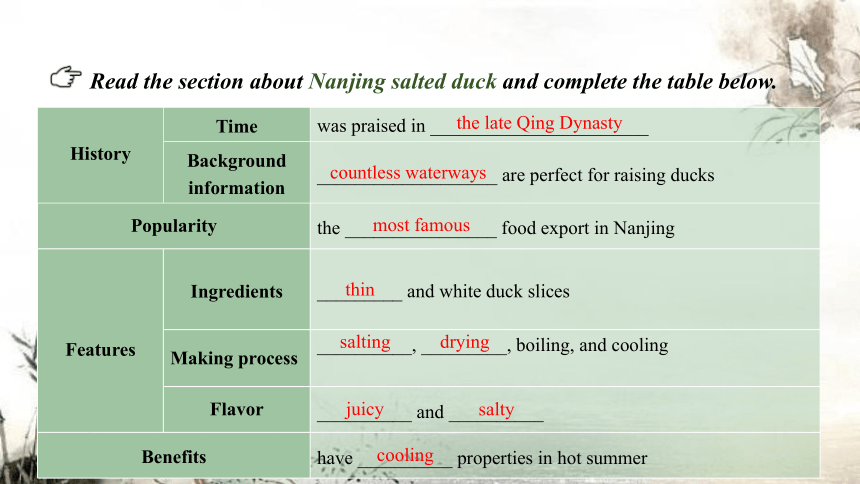
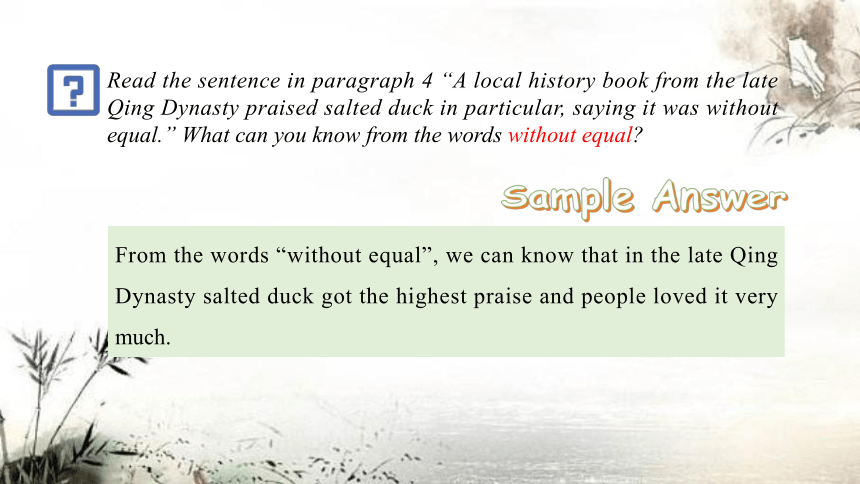
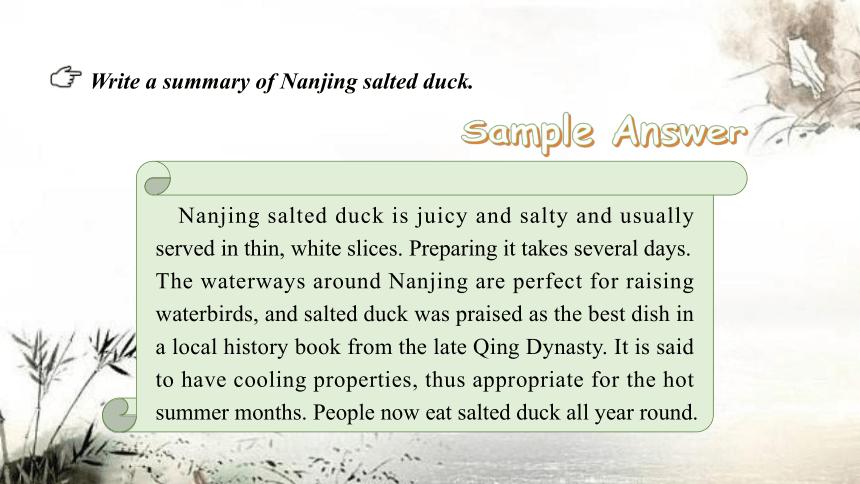
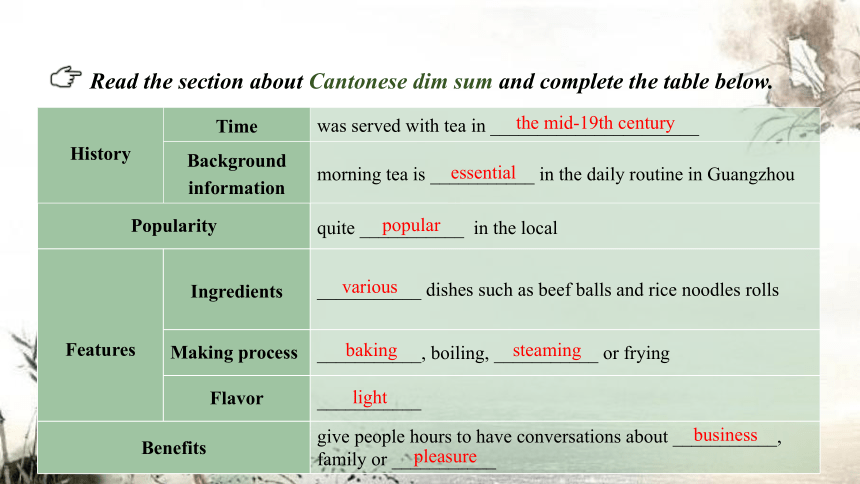
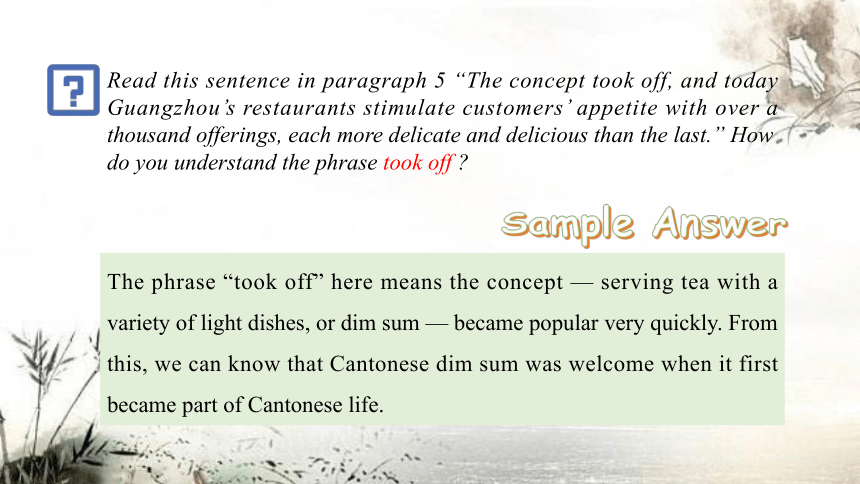
文档简介
(共40张PPT)
Extended reading
Unit 1 Food matters
Extended reading & Project
Lead-in
What food do you usually have for lunch and dinner
Fried dishes
Hot pot
Dumplings
What’s your favourite food and can you introduce something about it
What do you know about traditional Chinese dishes
Styles of cooking:
Chuan (Sichuan) cuisine, Lu (Shandong) cuisine, Yue (Guangdong) cuisine, Huaiyang (Jiangsu) cuisine, Min (Fujian) cuisine, Zhe (Zhejiang) cuisine, Hui (Anhui) cuisine, Xiang (Hunan) cuisine ...
Ways of cooking:
fry, boil, bake, grill, roast, steam, toast
Types of Courses:
Cold Dishes, Hot Dishes, Soup, Staples, Dim sum ...
History Time date back to the late Qing Dynasty
Background information perfect for the ______ and ______ climate
Popularity famous both in _________ and __________
Features Ingredients multiple __________, ___________, meats and ________ (e.g. ___________, Sichuan peppers, ________________ and red oil)
Making process __________ various ingredients
Flavor hot
Benefits __________ a cold midwinter evening and ____________ rivers of sweat on a summer afternoon; offer the best way to __________________
damp
foggy
China
overseas
soups
vegetables
sauces
chillies
spring onions
boiling
heat up
let loose
relax with friends
Reading
Read the section about hot pot and complete the table below.
These descriptive words are so vivid and specific that transport readers to Sichuan to enjoy the hot pot. Also from these words, we can see the author’s love for the hot pot.
In the first sentence of the first paragraph, the author uses mouth-watering and let loose rivers of sweat to describe hot pots of Sichuan, what do you think of these descriptive words
Sample Answer
“Quickened” means “made something more active”. From this sentence, we can know that people have more laughter and their conversation becomes more active when they enjoy Sichuan hot pot, so the meal really makes people relax themselves.
How do you understand the word quickened in the sentence “The hot flavour quickened our laughter and conversation, making the meal the perfect way to relax with friends.”
Sample Answer
Sichuan hot pots may date back to the late Qing Dynasty as a way for boatmen on the Yangtze River to keep warm during the cold and wet winters, and over time they have experienced developments. Now they are spicy, characterized by a pot of soup covered with chillies, Sichuan peppers, spring onions and red oil, served with fresh meat, fish, vegetables, etc. Sichuan hot pots are perfect for the damp, foggy climate in Sichuan and also a great way to relax with friends.
Write a summary of hot pot.
Sample Answer
History Time was praised in _______________________
Background information ___________________ are perfect for raising ducks
Popularity the ________________ food export in Nanjing
Features Ingredients _________ and white duck slices
Making process __________, _________, boiling, and cooling
Flavor __________ and __________
Benefits have __________ properties in hot summer
the late Qing Dynasty
countless waterways
most famous
thin
salting
drying
juicy
salty
cooling
Read the section about Nanjing salted duck and complete the table below.
From the words “without equal”, we can know that in the late Qing Dynasty salted duck got the highest praise and people loved it very much.
Read the sentence in paragraph 4 “A local history book from the late Qing Dynasty praised salted duck in particular, saying it was without equal.” What can you know from the words without equal
Sample Answer
Nanjing salted duck is juicy and salty and usually served in thin, white slices. Preparing it takes several days. The waterways around Nanjing are perfect for raising waterbirds, and salted duck was praised as the best dish in a local history book from the late Qing Dynasty. It is said to have cooling properties, thus appropriate for the hot summer months. People now eat salted duck all year round.
Write a summary of Nanjing salted duck.
Sample Answer
History Time was served with tea in ______________________
Background information morning tea is ___________ in the daily routine in Guangzhou
Popularity quite ___________ in the local
Features Ingredients ___________ dishes such as beef balls and rice noodles rolls
Making process ___________, boiling, ___________ or frying
Flavor ___________
Benefits give people hours to have conversations about ___________, family or ___________
the mid-19th century
essential
popular
various
baking
steaming
light
business
pleasure
Read the section about Cantonese dim sum and complete the table below.
The phrase “took off” here means the concept — serving tea with a variety of light dishes, or dim sum — became popular very quickly. From this, we can know that Cantonese dim sum was welcome when it first became part of Cantonese life.
Read this sentence in paragraph 5 “The concept took off, and today Guangzhou’s restaurants stimulate customers’ appetite with over a thousand offerings, each more delicate and delicious than the last.” How do you understand the phrase took off
Sample Answer
Cantonese dim sum was first served with tea in the mid-19th century and eating dim sum with tea has become an essential part of the daily routine for people in Guangzhou. It consists of a variety of small light dishes cooked in various ways such as baking, boiling, steaming or frying. There are over a thousand different dishes to try, and for hours, the locals drink tea, chat with each other, and enjoy the wide selection of dishes.
Write a summary of Cantonese dim sum.
Sample Answer
The food critic really loves these foods. We can know that from:
I instantly became a big fan of Sichuan hot pots and I’ll soon be back for more! (L19–20)
It definitely hit the spot when I tried it, and it has become one of my personal favourites. (L34–35)
A single visit is not enough to appreciate everything, and I have a long list of dim sum I still need to try. (L50–51)
What does the food critic think of the three traditional Chinese foods Please find out the supporting ideas.
Discussing
The local dish I want to introduce is Yangzhou fried rice. It might be the most famous dish in my hometown, Yangzhou. It is generally believed that the dish dates back to the Sui Dynasty when leftover rice was cooked together with egg and chopped green onion. Over the centuries different ingredients have been added, like meat, to create different recipes. During the Beijing Olympic Games, Yangzhou fried rice was one of the most popular Chinese foods enjoyed by many athletes from different countries. It is now increasingly found on menus in Chinese restaurants all around the world.
What dish is popular in your hometown Introduce it to a foreign traveller. Explain its popularity, history and features.
Sample Answer
Words and Expressions
1. Over time, it has expanded to include multiple options of soups, vegetables, meats and sauces,
appealing to people of different tastes. (P11)
后来,火锅的内容逐渐丰富,包括各式汤底以及品种多样的蔬菜、肉和调料,满足了人们
不同的口味。
expand vt. & vi. 增加,扩大;扩展,发展(业务);详谈,详述
搭配 expand the size of ... 扩大……的尺寸 expand business 扩展业务
expand on/upon 详述,充分叙述,详细阐明
例句
We expand the size of the family photo in order to hang it over our sofa.
为了把全家福挂在沙发上方,我们把它放大了。
The company expands its business from drinks to sportswear industry.
这家公司把业务从饮料拓展到运动服装行业。
Peter expanded on how the smart home works.
彼得详细地阐明了智能家居的工作原理。
单词
1. Over time, it has expanded to include multiple options of soups, vegetables, meats and sauces,
appealing to people of different tastes. (P11)
后来,火锅的内容逐渐丰富,包括各式汤底以及品种多样的蔬菜、肉和调料,满足了人们
不同的口味。
expand vt. & vi. 增加,扩大;扩展,发展(业务);详谈,详述
拓展
expansion n. 扩张,扩展,扩大,膨胀 further expansion 进一步扩张
expansive adj. 广阔的,辽阔的;广泛的,全面的
例句
Despite the recession, the company is confident of further expansion.
尽管经济衰退,公司对进一步扩张仍充满信心。
We need to look at a more expansive definition of the term.
我们需要考虑这个词所包含的更广泛意义。
2. Nowadays, people eat salted duck all year round and it is estimated that tens of thousands of
ducks are consumed every day in Nanjing! (P12)
如今,人们一年四季都吃盐水鸭,据估计南京人每天要吃掉数万只鸭子!
estimate vt. 估计,估价 n. 估计;估计的成本
搭配
be estimated to do sth 被估计做某事 it is estimated (that) ... 据估计……
make an estimate 作估计,作估算
例句
The painting is estimated to be worth over 1 million dollars.
这幅画估计价值超过一百万美元。
It is estimated that students wearing glasses account for 70 per cent of the whole students.
据估计,戴眼镜的学生占学生总数的70%。
拓展
underestimate vt. 低估,看轻 overestimate vt. 对……估计过高
2. Nowadays, people eat salted duck all year round and it is estimated that tens of thousands of
ducks are consumed every day in Nanjing! (P12)
如今,人们一年四季都吃盐水鸭,据估计南京人每天要吃掉数万只鸭子!
consume vt. 吃,喝,饮;消耗,耗费(尤指燃料、能量或时间)
例句
He consumed all the milk tea and sandwiches.
他喝光了所有的奶茶并吃完了所有的三明治。
The new energy car doesn’t consume a lot of fuel.
新能源汽车不会消耗很多燃料。
拓展
consumption n. 消耗,消耗量 consumer n. 消费者
例句
Energy consumption rises as countries industrialize. 能源消耗随着各国工业化而增加。
Firms have to be responsive to consumer demand. 公司必须对消费者的需求作出积极反应。
3. In Guangzhou, morning tea is such an essential part of the daily routine that “Have you had your
tea ” has become the local version of “Good morning.” (P12)
在广州,早茶是日常生活必不可少的一部分,以至于“你吃早茶了吗?”成了当地人问候
早安的方式。
essential adj. 必不可少的;本质的,基本的
搭配
an essential part of ... ……必不可少的一部分 be essential for/to ... 对……是极其重要的
it is essential that ... ……是完全必要的
例句
The essential difference between the two models of smartphones is recognition tech.
识别技术是这两款智能手机的本质区别。
Fresh fruits and vegetables are an essential part of a healthy diet.
新鲜的水果和蔬菜是健康饮食必不可少的一部分。
It is essential that you should read every document carefully before you sign it.
在签字前认真阅读每个文档是完全必要的。
3. In Guangzhou, morning tea is such an essential part of the daily routine that “Have you had your
tea ” has become the local version of “Good morning.” (P12)
在广州,早茶是日常生活必不可少的一部分,以至于“你吃早茶了吗?”成了当地人问候
早安的方式。
essential adj. 必不可少的;本质的,基本的
拓展
essential n. 必不可少的东西,必需品 essence n. 本质,实质
essentially adv. 本质上,根本上
例句
The house for rent has all the essentials like water heater and air conditioners.
这个出租的房子有所有的必需品,如热水器和空调。
In essence, both sides work toward the same goal.
从本质上讲,双方向同一个目标努力。
Essentially, the band’s new album is a collection of their greatest hits.
本质上来说,这个乐队的新专辑就是他们最热门歌曲的合集。
4. The emphasis is rather on conversation about business, family or pleasure, and locals can spend
hours together chatting, drinking tea and working their way through the menu. (P12)
重点是去谈生意、话家常、说乐子,当地人可以花上几小时聚在一起谈天、饮茶,慢慢吃
遍菜单上所有的点心。
emphasis n. (pl. emphases) 强调,重视;重读
搭配
put/lay/place emphasis on ... 强调/重视……
例句
We provide all types of courses, with an emphasis on the speaking course.
我们提供各种课程,尤其是口语课程。
拓展
emphasize vt. 强调,重视;使突出,使明显;重读
例句
He emphasized the importance of effective learning methods and good study habits.
他强调了有效的学习方法和良好的学习习惯的重要性。
1. The hot flavour is enough to heat up a cold midwinter evening or to let loose rivers of sweat on a
summer afternoon. (P11)
那火辣的风味足以温暖隆冬的寒夜,或在夏日的午后让人汗流浃背。
*动词不定式作结果状语
句式剖析
动词不定式to heat up a cold midwinter evening和to let loose rivers of sweat on a summer afternoon修饰enough作状语,表结果。
考点提炼
动词不定式在“be+形容词/副词 enough to do”、“too+形容词/副词+to do”句型中,动词不定式作结果状语。如:
The evidence is not convincing enough to prove his innocence.
证据不够有说服力,不能够证明他是清白的。
He is not old enough to lead an independent life.
他年龄还小,不能独立生活。
句式
动词不定式作结果状语,常指意想不到的结果,通常会在动词不定式前面加only。如:
He hurried to the train station, only to find the train gone.
他急忙赶到火车站,发现火车已经开走了。
归纳拓展
(1) 动词不定式与in order和so as连用作目的状语。如:
In order to meet the deadline, I have been staying up late to write my essay for the last two weeks.
为了按时完成,过去两周我一直在熬夜写论文。
My dad keeps controlling his diet in order to/so as to control his blood sugar.
我爸爸一直控制他的饮食以控制血糖。
(2) 动词不定式在sorry、glad、surprised、eager、afraid、pleased、proud、disappointed、ashamed等表示情绪的形容词后作原因状语。如:
Dad was so disappointed to find that I cheated in the exam. 爸爸发现我在考试中作弊很失望。
Tom is sorry to break the vase. 汤姆为打碎花瓶感到抱歉。
2. The concept took off, and today Guangzhou’s restaurants stimulate customers’ appetite with over
a thousand offerings, each more delicate and delicious than the last. (P12)
这种观念时兴起来,如今广州的餐厅用一千多种点心刺激着食客的食欲,一道比一道精致、
可口。
*独立主格结构
句式剖析
句中each more delicate and delicious than the last是独立主格结构。前一部分是代词each,后一部分是形容词的比较级more delicate and delicious than the last。前后两部分具有逻辑上的主谓关系。
考点提炼
独立主格结构相当于状语从句或者并列结构,有三个特点:①独立主格结构和主句之间一般用逗号隔开;②独立主格结构中的两部分可以构成主谓关系;③主句的主语和独立主格结构的逻辑主语不一致。如:
A wave of terror sweeping over him, he stood rooted to the ground.
一阵恐惧席卷了他,他呆若木鸡地站着。
归纳拓展
除形容词外,独立主格结构中的第二部分还可以是名词或代词+动词不定式、动词-ing形式、动词-ed形式、副词、名词和介词短语等。如:
(1) 非谓语动词
My brother watching cartoon in my room, I have no option but to study in the living room.
弟弟在我的房间里看动画片,我除了在客厅学习没有别的选择。
(2) 副词
All the lights on, I wasn’t getting any sleep. 所有的灯都开着,我根本没睡着。
(3) 名词
His daughter toddler, the police died in a gun battle.
女儿才蹒跚学步,这名警察在一场枪战中丧生。
(4) 介词短语
A stick in his hand, he protected the girl against the attack.
他手里拿着一根棍子保护那个女孩免受攻击。
3. The Cantonese do not hurry over their breakfasts, as I found when I visited a restaurant in
Guangzhou’s old city centre this morning. (P12)
广东人早餐并不匆忙,正如今天早晨我在广州老城区中心的一家餐馆所见的那样。
*as引导的非限制性定语从句
句式剖析
句中as引导非限制性定语从句,指代The Cantonese do not hurry over their breakfasts这句话,在从句中充当宾语。
考点提炼
非限制性定语从句对先行词起补充说明的作用,去掉后,主句意思依然完整;先行词与定语从句往往用逗号隔开;常用的引导词有:which、who、whom、whose、as、when、where等。有时可以用“介词+which/whom”引导非限制性定语从句。that和why不可以引导非限制定语从句。在非限制性定语从句中,引导词不可以省略,which也不可以用that替代。如:
A wonderful speech was delivered by a well-informed professor, from which I got a thorough understanding of the history of Nanjing.
一位学识渊博的教授做了一场精彩的演讲,让我对南京的历史有了深入的了解。
归纳拓展
关系代词which和as都可以引导非限制性定语从句,但有两个主要的区别:which只能置于主句后,as的位置比较灵活,可以位于主句前、主句中和主句后。as有“正如”的含义,which没有。如:
As we had expected, Tom scored the two crucial goals in the final.
正如我们所料,汤姆在决赛中进了两个关键的球。
He took the job seriously, which set us a good example.
他对待工作认真负责,给我们树立了好榜样。
Project
Making a dish
Project
Learning objectives
By the end of this section, you will be able to:
research the recipe of a chosen dish through cooperation and exploration;
use group work to write and present the recipe;
make a video of how the dish is made and then make a presentation;
evaluate and comment on each other’s work.
Preparing
As a class, discuss dishes from around the world or new dishes you would like to create. Then in groups, choose a dish to research.
As a group, research the recipe for your chosen dish. Use the example below to help you.
What is a recipe
A recipe is a set of instructions that tells you how to cook something and the ingredients you need for it.
Implementing
Tips
How to write a recipe
Provide exact figures about the amount of ingredients and time needed when possible.
Employ specific and accurate verbs to give instructions.
List the instructions in order.
Add some tips if necessary.
As a group, make a video or take some photos of how you make the dish. Use the example to help you. Then present your video or photos to the rest of the class.
Video script
Presenter:
Today I’ll show you how to make dumplings. Here are the ingredients and seasoning I’ve
prepared: meat, Chinese cabbage, dumpling wrappers, salt, oil and cooking wine. These dumpling wrappers were bought from the market, but you can make your own if you want to.
Now let’s start to make the dumplings. First, cut the meat and the Chinese cabbage into pieces. Salt the Chinese cabbage, let it rest for about fifteen minutes and press out extra water. Then mix the meat and the Chinese cabbage together. Add some oil, salt and cooking wine to the mixture. The dumpling filling is ready. Next, fill the dumpling wrappers with the mixture. Place an open wrapper in the middle of the hand and put some filling into the wrapper. Don’t overfill the dumpling or it will break open while it boils.
Now stick the edges of the dumpling wrapper together. Use water to help the edges stick together. This is a little difficult so do it very carefully. The next step is to boil the dumplings. Remember, you can’t put the dumplings into the pot before the water boils. Gently put the dumplings into a pot of boiling water. Now you can see the water stops boiling. When the water boils again, add some cold water into the pot, and repeat this step a couple of times. Finally, set the cooked dumplings on a plate and serve with vinegar.
Hot and steamy dumplings! Now I can enjoy them.
Discuss in groups to think about all the work that needs to be done and how to divide the work properly among the group members.
Search for information.
Organize the information to write a recipe.
Prepare ingredients and make a dish.
Record the process of making the dish.
Make a presentation.
Speak clearly and confidently.
Make eye contact with the audience.
Keep your facial expressions relaxed and friendly.
Talk at a proper speed and pause when it is necessary to give your audience time to think about what you have said.
Tips for making a presentation
Evaluating
Vote on which one is the best. And comment on each other’s work.
Review the words and expressions learned this class.
Polish up your video based on teacher’s and classmates’ evaluation.
Homework
Extended reading
Unit 1 Food matters
Extended reading & Project
Lead-in
What food do you usually have for lunch and dinner
Fried dishes
Hot pot
Dumplings
What’s your favourite food and can you introduce something about it
What do you know about traditional Chinese dishes
Styles of cooking:
Chuan (Sichuan) cuisine, Lu (Shandong) cuisine, Yue (Guangdong) cuisine, Huaiyang (Jiangsu) cuisine, Min (Fujian) cuisine, Zhe (Zhejiang) cuisine, Hui (Anhui) cuisine, Xiang (Hunan) cuisine ...
Ways of cooking:
fry, boil, bake, grill, roast, steam, toast
Types of Courses:
Cold Dishes, Hot Dishes, Soup, Staples, Dim sum ...
History Time date back to the late Qing Dynasty
Background information perfect for the ______ and ______ climate
Popularity famous both in _________ and __________
Features Ingredients multiple __________, ___________, meats and ________ (e.g. ___________, Sichuan peppers, ________________ and red oil)
Making process __________ various ingredients
Flavor hot
Benefits __________ a cold midwinter evening and ____________ rivers of sweat on a summer afternoon; offer the best way to __________________
damp
foggy
China
overseas
soups
vegetables
sauces
chillies
spring onions
boiling
heat up
let loose
relax with friends
Reading
Read the section about hot pot and complete the table below.
These descriptive words are so vivid and specific that transport readers to Sichuan to enjoy the hot pot. Also from these words, we can see the author’s love for the hot pot.
In the first sentence of the first paragraph, the author uses mouth-watering and let loose rivers of sweat to describe hot pots of Sichuan, what do you think of these descriptive words
Sample Answer
“Quickened” means “made something more active”. From this sentence, we can know that people have more laughter and their conversation becomes more active when they enjoy Sichuan hot pot, so the meal really makes people relax themselves.
How do you understand the word quickened in the sentence “The hot flavour quickened our laughter and conversation, making the meal the perfect way to relax with friends.”
Sample Answer
Sichuan hot pots may date back to the late Qing Dynasty as a way for boatmen on the Yangtze River to keep warm during the cold and wet winters, and over time they have experienced developments. Now they are spicy, characterized by a pot of soup covered with chillies, Sichuan peppers, spring onions and red oil, served with fresh meat, fish, vegetables, etc. Sichuan hot pots are perfect for the damp, foggy climate in Sichuan and also a great way to relax with friends.
Write a summary of hot pot.
Sample Answer
History Time was praised in _______________________
Background information ___________________ are perfect for raising ducks
Popularity the ________________ food export in Nanjing
Features Ingredients _________ and white duck slices
Making process __________, _________, boiling, and cooling
Flavor __________ and __________
Benefits have __________ properties in hot summer
the late Qing Dynasty
countless waterways
most famous
thin
salting
drying
juicy
salty
cooling
Read the section about Nanjing salted duck and complete the table below.
From the words “without equal”, we can know that in the late Qing Dynasty salted duck got the highest praise and people loved it very much.
Read the sentence in paragraph 4 “A local history book from the late Qing Dynasty praised salted duck in particular, saying it was without equal.” What can you know from the words without equal
Sample Answer
Nanjing salted duck is juicy and salty and usually served in thin, white slices. Preparing it takes several days. The waterways around Nanjing are perfect for raising waterbirds, and salted duck was praised as the best dish in a local history book from the late Qing Dynasty. It is said to have cooling properties, thus appropriate for the hot summer months. People now eat salted duck all year round.
Write a summary of Nanjing salted duck.
Sample Answer
History Time was served with tea in ______________________
Background information morning tea is ___________ in the daily routine in Guangzhou
Popularity quite ___________ in the local
Features Ingredients ___________ dishes such as beef balls and rice noodles rolls
Making process ___________, boiling, ___________ or frying
Flavor ___________
Benefits give people hours to have conversations about ___________, family or ___________
the mid-19th century
essential
popular
various
baking
steaming
light
business
pleasure
Read the section about Cantonese dim sum and complete the table below.
The phrase “took off” here means the concept — serving tea with a variety of light dishes, or dim sum — became popular very quickly. From this, we can know that Cantonese dim sum was welcome when it first became part of Cantonese life.
Read this sentence in paragraph 5 “The concept took off, and today Guangzhou’s restaurants stimulate customers’ appetite with over a thousand offerings, each more delicate and delicious than the last.” How do you understand the phrase took off
Sample Answer
Cantonese dim sum was first served with tea in the mid-19th century and eating dim sum with tea has become an essential part of the daily routine for people in Guangzhou. It consists of a variety of small light dishes cooked in various ways such as baking, boiling, steaming or frying. There are over a thousand different dishes to try, and for hours, the locals drink tea, chat with each other, and enjoy the wide selection of dishes.
Write a summary of Cantonese dim sum.
Sample Answer
The food critic really loves these foods. We can know that from:
I instantly became a big fan of Sichuan hot pots and I’ll soon be back for more! (L19–20)
It definitely hit the spot when I tried it, and it has become one of my personal favourites. (L34–35)
A single visit is not enough to appreciate everything, and I have a long list of dim sum I still need to try. (L50–51)
What does the food critic think of the three traditional Chinese foods Please find out the supporting ideas.
Discussing
The local dish I want to introduce is Yangzhou fried rice. It might be the most famous dish in my hometown, Yangzhou. It is generally believed that the dish dates back to the Sui Dynasty when leftover rice was cooked together with egg and chopped green onion. Over the centuries different ingredients have been added, like meat, to create different recipes. During the Beijing Olympic Games, Yangzhou fried rice was one of the most popular Chinese foods enjoyed by many athletes from different countries. It is now increasingly found on menus in Chinese restaurants all around the world.
What dish is popular in your hometown Introduce it to a foreign traveller. Explain its popularity, history and features.
Sample Answer
Words and Expressions
1. Over time, it has expanded to include multiple options of soups, vegetables, meats and sauces,
appealing to people of different tastes. (P11)
后来,火锅的内容逐渐丰富,包括各式汤底以及品种多样的蔬菜、肉和调料,满足了人们
不同的口味。
expand vt. & vi. 增加,扩大;扩展,发展(业务);详谈,详述
搭配 expand the size of ... 扩大……的尺寸 expand business 扩展业务
expand on/upon 详述,充分叙述,详细阐明
例句
We expand the size of the family photo in order to hang it over our sofa.
为了把全家福挂在沙发上方,我们把它放大了。
The company expands its business from drinks to sportswear industry.
这家公司把业务从饮料拓展到运动服装行业。
Peter expanded on how the smart home works.
彼得详细地阐明了智能家居的工作原理。
单词
1. Over time, it has expanded to include multiple options of soups, vegetables, meats and sauces,
appealing to people of different tastes. (P11)
后来,火锅的内容逐渐丰富,包括各式汤底以及品种多样的蔬菜、肉和调料,满足了人们
不同的口味。
expand vt. & vi. 增加,扩大;扩展,发展(业务);详谈,详述
拓展
expansion n. 扩张,扩展,扩大,膨胀 further expansion 进一步扩张
expansive adj. 广阔的,辽阔的;广泛的,全面的
例句
Despite the recession, the company is confident of further expansion.
尽管经济衰退,公司对进一步扩张仍充满信心。
We need to look at a more expansive definition of the term.
我们需要考虑这个词所包含的更广泛意义。
2. Nowadays, people eat salted duck all year round and it is estimated that tens of thousands of
ducks are consumed every day in Nanjing! (P12)
如今,人们一年四季都吃盐水鸭,据估计南京人每天要吃掉数万只鸭子!
estimate vt. 估计,估价 n. 估计;估计的成本
搭配
be estimated to do sth 被估计做某事 it is estimated (that) ... 据估计……
make an estimate 作估计,作估算
例句
The painting is estimated to be worth over 1 million dollars.
这幅画估计价值超过一百万美元。
It is estimated that students wearing glasses account for 70 per cent of the whole students.
据估计,戴眼镜的学生占学生总数的70%。
拓展
underestimate vt. 低估,看轻 overestimate vt. 对……估计过高
2. Nowadays, people eat salted duck all year round and it is estimated that tens of thousands of
ducks are consumed every day in Nanjing! (P12)
如今,人们一年四季都吃盐水鸭,据估计南京人每天要吃掉数万只鸭子!
consume vt. 吃,喝,饮;消耗,耗费(尤指燃料、能量或时间)
例句
He consumed all the milk tea and sandwiches.
他喝光了所有的奶茶并吃完了所有的三明治。
The new energy car doesn’t consume a lot of fuel.
新能源汽车不会消耗很多燃料。
拓展
consumption n. 消耗,消耗量 consumer n. 消费者
例句
Energy consumption rises as countries industrialize. 能源消耗随着各国工业化而增加。
Firms have to be responsive to consumer demand. 公司必须对消费者的需求作出积极反应。
3. In Guangzhou, morning tea is such an essential part of the daily routine that “Have you had your
tea ” has become the local version of “Good morning.” (P12)
在广州,早茶是日常生活必不可少的一部分,以至于“你吃早茶了吗?”成了当地人问候
早安的方式。
essential adj. 必不可少的;本质的,基本的
搭配
an essential part of ... ……必不可少的一部分 be essential for/to ... 对……是极其重要的
it is essential that ... ……是完全必要的
例句
The essential difference between the two models of smartphones is recognition tech.
识别技术是这两款智能手机的本质区别。
Fresh fruits and vegetables are an essential part of a healthy diet.
新鲜的水果和蔬菜是健康饮食必不可少的一部分。
It is essential that you should read every document carefully before you sign it.
在签字前认真阅读每个文档是完全必要的。
3. In Guangzhou, morning tea is such an essential part of the daily routine that “Have you had your
tea ” has become the local version of “Good morning.” (P12)
在广州,早茶是日常生活必不可少的一部分,以至于“你吃早茶了吗?”成了当地人问候
早安的方式。
essential adj. 必不可少的;本质的,基本的
拓展
essential n. 必不可少的东西,必需品 essence n. 本质,实质
essentially adv. 本质上,根本上
例句
The house for rent has all the essentials like water heater and air conditioners.
这个出租的房子有所有的必需品,如热水器和空调。
In essence, both sides work toward the same goal.
从本质上讲,双方向同一个目标努力。
Essentially, the band’s new album is a collection of their greatest hits.
本质上来说,这个乐队的新专辑就是他们最热门歌曲的合集。
4. The emphasis is rather on conversation about business, family or pleasure, and locals can spend
hours together chatting, drinking tea and working their way through the menu. (P12)
重点是去谈生意、话家常、说乐子,当地人可以花上几小时聚在一起谈天、饮茶,慢慢吃
遍菜单上所有的点心。
emphasis n. (pl. emphases) 强调,重视;重读
搭配
put/lay/place emphasis on ... 强调/重视……
例句
We provide all types of courses, with an emphasis on the speaking course.
我们提供各种课程,尤其是口语课程。
拓展
emphasize vt. 强调,重视;使突出,使明显;重读
例句
He emphasized the importance of effective learning methods and good study habits.
他强调了有效的学习方法和良好的学习习惯的重要性。
1. The hot flavour is enough to heat up a cold midwinter evening or to let loose rivers of sweat on a
summer afternoon. (P11)
那火辣的风味足以温暖隆冬的寒夜,或在夏日的午后让人汗流浃背。
*动词不定式作结果状语
句式剖析
动词不定式to heat up a cold midwinter evening和to let loose rivers of sweat on a summer afternoon修饰enough作状语,表结果。
考点提炼
动词不定式在“be+形容词/副词 enough to do”、“too+形容词/副词+to do”句型中,动词不定式作结果状语。如:
The evidence is not convincing enough to prove his innocence.
证据不够有说服力,不能够证明他是清白的。
He is not old enough to lead an independent life.
他年龄还小,不能独立生活。
句式
动词不定式作结果状语,常指意想不到的结果,通常会在动词不定式前面加only。如:
He hurried to the train station, only to find the train gone.
他急忙赶到火车站,发现火车已经开走了。
归纳拓展
(1) 动词不定式与in order和so as连用作目的状语。如:
In order to meet the deadline, I have been staying up late to write my essay for the last two weeks.
为了按时完成,过去两周我一直在熬夜写论文。
My dad keeps controlling his diet in order to/so as to control his blood sugar.
我爸爸一直控制他的饮食以控制血糖。
(2) 动词不定式在sorry、glad、surprised、eager、afraid、pleased、proud、disappointed、ashamed等表示情绪的形容词后作原因状语。如:
Dad was so disappointed to find that I cheated in the exam. 爸爸发现我在考试中作弊很失望。
Tom is sorry to break the vase. 汤姆为打碎花瓶感到抱歉。
2. The concept took off, and today Guangzhou’s restaurants stimulate customers’ appetite with over
a thousand offerings, each more delicate and delicious than the last. (P12)
这种观念时兴起来,如今广州的餐厅用一千多种点心刺激着食客的食欲,一道比一道精致、
可口。
*独立主格结构
句式剖析
句中each more delicate and delicious than the last是独立主格结构。前一部分是代词each,后一部分是形容词的比较级more delicate and delicious than the last。前后两部分具有逻辑上的主谓关系。
考点提炼
独立主格结构相当于状语从句或者并列结构,有三个特点:①独立主格结构和主句之间一般用逗号隔开;②独立主格结构中的两部分可以构成主谓关系;③主句的主语和独立主格结构的逻辑主语不一致。如:
A wave of terror sweeping over him, he stood rooted to the ground.
一阵恐惧席卷了他,他呆若木鸡地站着。
归纳拓展
除形容词外,独立主格结构中的第二部分还可以是名词或代词+动词不定式、动词-ing形式、动词-ed形式、副词、名词和介词短语等。如:
(1) 非谓语动词
My brother watching cartoon in my room, I have no option but to study in the living room.
弟弟在我的房间里看动画片,我除了在客厅学习没有别的选择。
(2) 副词
All the lights on, I wasn’t getting any sleep. 所有的灯都开着,我根本没睡着。
(3) 名词
His daughter toddler, the police died in a gun battle.
女儿才蹒跚学步,这名警察在一场枪战中丧生。
(4) 介词短语
A stick in his hand, he protected the girl against the attack.
他手里拿着一根棍子保护那个女孩免受攻击。
3. The Cantonese do not hurry over their breakfasts, as I found when I visited a restaurant in
Guangzhou’s old city centre this morning. (P12)
广东人早餐并不匆忙,正如今天早晨我在广州老城区中心的一家餐馆所见的那样。
*as引导的非限制性定语从句
句式剖析
句中as引导非限制性定语从句,指代The Cantonese do not hurry over their breakfasts这句话,在从句中充当宾语。
考点提炼
非限制性定语从句对先行词起补充说明的作用,去掉后,主句意思依然完整;先行词与定语从句往往用逗号隔开;常用的引导词有:which、who、whom、whose、as、when、where等。有时可以用“介词+which/whom”引导非限制性定语从句。that和why不可以引导非限制定语从句。在非限制性定语从句中,引导词不可以省略,which也不可以用that替代。如:
A wonderful speech was delivered by a well-informed professor, from which I got a thorough understanding of the history of Nanjing.
一位学识渊博的教授做了一场精彩的演讲,让我对南京的历史有了深入的了解。
归纳拓展
关系代词which和as都可以引导非限制性定语从句,但有两个主要的区别:which只能置于主句后,as的位置比较灵活,可以位于主句前、主句中和主句后。as有“正如”的含义,which没有。如:
As we had expected, Tom scored the two crucial goals in the final.
正如我们所料,汤姆在决赛中进了两个关键的球。
He took the job seriously, which set us a good example.
他对待工作认真负责,给我们树立了好榜样。
Project
Making a dish
Project
Learning objectives
By the end of this section, you will be able to:
research the recipe of a chosen dish through cooperation and exploration;
use group work to write and present the recipe;
make a video of how the dish is made and then make a presentation;
evaluate and comment on each other’s work.
Preparing
As a class, discuss dishes from around the world or new dishes you would like to create. Then in groups, choose a dish to research.
As a group, research the recipe for your chosen dish. Use the example below to help you.
What is a recipe
A recipe is a set of instructions that tells you how to cook something and the ingredients you need for it.
Implementing
Tips
How to write a recipe
Provide exact figures about the amount of ingredients and time needed when possible.
Employ specific and accurate verbs to give instructions.
List the instructions in order.
Add some tips if necessary.
As a group, make a video or take some photos of how you make the dish. Use the example to help you. Then present your video or photos to the rest of the class.
Video script
Presenter:
Today I’ll show you how to make dumplings. Here are the ingredients and seasoning I’ve
prepared: meat, Chinese cabbage, dumpling wrappers, salt, oil and cooking wine. These dumpling wrappers were bought from the market, but you can make your own if you want to.
Now let’s start to make the dumplings. First, cut the meat and the Chinese cabbage into pieces. Salt the Chinese cabbage, let it rest for about fifteen minutes and press out extra water. Then mix the meat and the Chinese cabbage together. Add some oil, salt and cooking wine to the mixture. The dumpling filling is ready. Next, fill the dumpling wrappers with the mixture. Place an open wrapper in the middle of the hand and put some filling into the wrapper. Don’t overfill the dumpling or it will break open while it boils.
Now stick the edges of the dumpling wrapper together. Use water to help the edges stick together. This is a little difficult so do it very carefully. The next step is to boil the dumplings. Remember, you can’t put the dumplings into the pot before the water boils. Gently put the dumplings into a pot of boiling water. Now you can see the water stops boiling. When the water boils again, add some cold water into the pot, and repeat this step a couple of times. Finally, set the cooked dumplings on a plate and serve with vinegar.
Hot and steamy dumplings! Now I can enjoy them.
Discuss in groups to think about all the work that needs to be done and how to divide the work properly among the group members.
Search for information.
Organize the information to write a recipe.
Prepare ingredients and make a dish.
Record the process of making the dish.
Make a presentation.
Speak clearly and confidently.
Make eye contact with the audience.
Keep your facial expressions relaxed and friendly.
Talk at a proper speed and pause when it is necessary to give your audience time to think about what you have said.
Tips for making a presentation
Evaluating
Vote on which one is the best. And comment on each other’s work.
Review the words and expressions learned this class.
Polish up your video based on teacher’s and classmates’ evaluation.
Homework
同课章节目录
- Unit 1 Food matters
- Welcome to the unit
- Reading
- Grammar and usage
- Integrated skills
- Extended reading
- Project
- Unit 2 The Universal Language
- Welcome to the unit
- Reading
- Grammar and usage
- Integrated skills
- Extended reading
- Project
- Unit 3 The art of painting
- Welcome to the unit
- Reading
- Grammar and usage
- Integrated skills
- Extended reading
- Project
- Unit 4 Exploring poetry
- Welcome to the unit
- Reading
- Grammar and usage
- Integrated skills
- Extended reading
- Project
